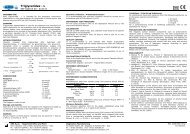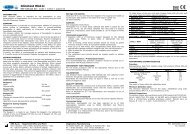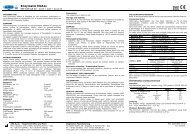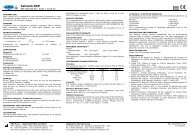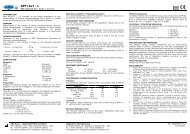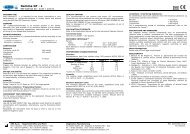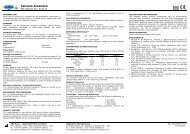Bilirubin Total - Gdsrl.com
Bilirubin Total - Gdsrl.com
Bilirubin Total - Gdsrl.com
You also want an ePaper? Increase the reach of your titles
YUMPU automatically turns print PDFs into web optimized ePapers that Google loves.
<strong>Bilirubin</strong> <strong>Total</strong><br />
REF SA4231 00 - 6x15 + 1x4,5 ml<br />
INTENDED USE<br />
AMS <strong>Bilirubin</strong> <strong>Total</strong> is intended for the colorimetric quantitative in vitro<br />
determination of total bilirubin in human serum and plasma using the<br />
AMS Sat-450 Chemistry System.<br />
SUMMARY<br />
A reaction in which bilirubin is coupled with diazotized sulfanilic acid (ρdiazobenzenesulfonic<br />
acid) to produce an azo dye was first described by<br />
Ehrlich in 1884. The color of this derivative is pink in an acid medium<br />
and blue in an alkaline one. The measurement of the blue form has<br />
been more popular because of greater sensitivity.<br />
Two types of serum bilirubin can be distinguished and quantitated by<br />
the diazo reaction. The direct form, consists of conjugated, watersoluble<br />
derivatives and reacts in the absence of an accelerating or<br />
solubilizing agent. The indirect form, consists of free, unconjugated<br />
bilirubin bound to serum albumin. This form only reacts in the presence<br />
of an accelerating agent. The sum of these two forms is termed total<br />
bilirubin. The differentiation between direct and indirect is important in<br />
diagnosing causes of hyperbilirubinemia.<br />
METHOD PRINCIPLE<br />
In the present method (Jendrassik modified) total <strong>Bilirubin</strong>, in the<br />
presence of Diazosulphanilic acid, forms a coloured <strong>com</strong>pound<br />
(Azobilirubin) which absorbs at 546 nm. The colour intensity is<br />
proportional to the total <strong>Bilirubin</strong> concentration present in the sample.<br />
COMPOSITION<br />
Reagent 1<br />
Sulphanilic acid 6 mmol/l<br />
DMSO 7 mol/l<br />
Surfactants and preservatives<br />
Reagent 2<br />
Sodium nitrite 20 mmol/l<br />
Preparation<br />
Prepare the Working Solution by adding 750 µl of Reagent 2 into one<br />
vial of Reagent 1. Mix well.<br />
Storage and stability<br />
Store at room temperature (15-25 °C). Do not freeze the reagents! The<br />
reagents are stable up to the expiry date stated on the label when kept<br />
in closed vial.<br />
On board stability of Working Solution: 7 days<br />
SAMPLES<br />
Fresh unhemolysed serum or plasma. Serum samples must be assayed<br />
within 2 hours.<br />
Sample turbidity due to macromolecular aggregates may interfere. In<br />
this case, centrifuge or filtration through a 0.2 µ membrane filter is<br />
suggested. Avoid light exposure.<br />
Specimen collection / Preanalytical factors<br />
It is re<strong>com</strong>mended that specimen collection should be carried out in<br />
accordance with NCCLS protocol H11-A3.<br />
INSTRUMENT TEST PROCEDURE<br />
For the assay procedure refer to the Application Manual and to the<br />
instrument Operator Manual.<br />
CALIBRATION<br />
Use GD-Cal (REF GD8577 00). See calibrator insert sheet for lot specific<br />
concentration and traceability.<br />
Recalibrate the instrument every 24 hours or when a new lot or new<br />
bottle of reagent is used.<br />
QUALITY CONTROL<br />
It is re<strong>com</strong>mended to use controls with known uric acid concentration.<br />
Check that the values obtained are within the reference range provided.<br />
Normal and abnormal controls such as GD-Norm (REF GD8580 00) and<br />
GD-Path (REF GD8582 00) are re<strong>com</strong>mended.<br />
Refer to Westgard et al. (3) for identification and resolution of out of<br />
control situations.<br />
CALCULATION OF RESULTS<br />
Refer to the Application Manual and to the instrument Operator Manual.<br />
Conversion factor<br />
<strong>Bilirubin</strong> [mg/dl] x 17,1 = <strong>Bilirubin</strong> [µmol/l].<br />
REFERENCE INTERVALS (1)<br />
Serum:<br />
Males/Femalers: 0,2 - 1,2 mg/dl 3 - 20 µmol/l<br />
Each laboratory should establish reference ranges for its own<br />
patients population.<br />
PERFORMANCE CHARACTERISTICS<br />
Precision<br />
Representative data from studies using CLSI protocol NCCLS EP5-A2<br />
are summarized below.<br />
Control Level 1 Level 2<br />
Number of Observations N 76* 76*<br />
Number of Runs N 38 38<br />
Mean mg/dl 0,65 3,93<br />
Within Run %CV 1,4 0,6<br />
<strong>Total</strong> %CV 3,0 2,4<br />
*Outliers not included in statistical calculation<br />
Linearity<br />
The linearity range, established using CLSI protocol NCCLS EP6-A is<br />
0,1 - 27,5 mg/dl (1,7 - 470,3 µmol/l).<br />
Minimum Detection Limit<br />
The minimum detection limit for the assay, established using CLSI<br />
protocol NCCLS EP17-A, is 0,1 mg/dl (1,7 µmol/l).<br />
Method Comparison<br />
Correlation studies were performed using CLSI protocol NCCLS EP9-A2.<br />
Serum results from this assay on Sat-450 were <strong>com</strong>pared with those<br />
from a <strong>com</strong>mercially available analogous system. Results were as<br />
follows: N = 42, y = 0,993x - 0,04 mg/dl, r = 0,999.<br />
AMS S.p.A. – Registered Office and Plant Diagnostics Manufacturing<br />
Via E. Barsanti 17/A | 00012 Guidonia (Rome) – Italy Via Galileo Galilei, 38 | Seggiano di Pioltello (MI) - Italy<br />
Ph. +39 0774 354441 | Fax +39 0774 578035 Ph. +39 02 929189.1 | Fax +39 02 929189.39<br />
www.ams-analyzers.<strong>com</strong> | info@ams-analyzers.<strong>com</strong> www.gdsrl.<strong>com</strong> | infodiagnostics@ams-analyzers.<strong>com</strong><br />
Limitations / Interfering Substances<br />
No interferences have been observed from the following substances up<br />
to the below reported concentration:<br />
Hemoglobin > 500 mg/dl<br />
Triglycerides > 2000 mg/dl<br />
For a <strong>com</strong>prehensive review of interfering substances, refer to the<br />
publication by Young (2) .<br />
PRECAUTIONS AND WARNINGS<br />
The reagents contain inactive <strong>com</strong>ponents such as preservatives<br />
(Sodium azide or others), surfactants etc. The total concentration of<br />
these <strong>com</strong>ponents is lower than the limits reported by 67/548/EEC and<br />
88/379/EEC directives about classification, packaging and labelling of<br />
dangerous substances. However, the reagents should be handled with<br />
caution, avoiding swallowing and contact with skin, eyes and mucous<br />
membranes. The use of laboratory reagents according to good<br />
laboratory practice is re<strong>com</strong>mended.<br />
Waste Management<br />
Please refer to local legal requirements.<br />
BIBLIOGRAPHY<br />
1. Gambino, S.R., et al, <strong>Bilirubin</strong> Assay (Revised), Commission on<br />
Continuing Education, Am. Soc. of Clin. Path., Chicago, (1968).<br />
2. Young D.S., Effects of Drugs on Clinical Laboratory Tests, AACC<br />
Press, Washington, D.C., 1990.<br />
3. Westgard J., and Barry P., Cost- Effective Quality Control: Managing<br />
the Quality and Productivity of Analytical Processes, AACC Press,<br />
Washington, D.C., 1986.<br />
4. Henry J.B. Clinical Diagnosis and managements.<br />
5. Jendrassik L., Grof P. Biochemistry 297, 81 (1938).<br />
6. Schellong G., Wende U. Klin. Wschr. 38, 703 (1960)<br />
7. NCCLS Document, “Procedures for the collection of arterial blood<br />
specimens”, Approved Standard, 3rd Ed. (1999).<br />
8. EU-Dir 1999/11 Commission Directive of 8 March 1999 adapting to<br />
technical progress the principles of good laboratory practice as<br />
specified in Council Directive 87/18/EEC<br />
Met. SA423100.0 Eng<br />
Ed. 10/2012
<strong>Bilirubin</strong>a <strong>Total</strong>e<br />
REF SA4231 00 - 6x15 + 1x4,5 ml<br />
USO<br />
Il kit AMS <strong>Bilirubin</strong>a <strong>Total</strong>e viene impiegato per la determinazione<br />
colorimetrica quantitative in vitro della bilirubina totale nel siero e<br />
plasma umano con sistema AMS Sat-450.<br />
SOMMARIO<br />
Un dosaggio in cui la bilirubina reagisce con l’acido solfanilico<br />
diazotizato (acido p-diazobenzenesulfonico) per produrre un <strong>com</strong>posto<br />
colorato è stata descritto per la prima volta nel 1884 da Ehrlich. Il<br />
colore di questo derivato è rosa in ambiente acido e blu in ambiente<br />
alcalino. La misura della forma blu si è diffusa particolarmente offrendo<br />
una maggiore sensibilità.<br />
Tramite la reazione di diazotazione è possibile distinguere due tipi di<br />
bilirubina. La forma diretta è costituita da bilirubina coniugata a<br />
<strong>com</strong>posti che rendono solubile la bilirubina in ambiente acquoso<br />
reagisce con il diazo in assenza di agenti acceleranti. La forma indiretta<br />
è rappresentata dalla bilirubina libera, non-coniugata all’albumina;<br />
quest’ultima reagisce solo in presenza di un agente accelerante<br />
(solubilizzante). La somma delle due forme rappresenta la bilirubina<br />
totale. La differenziazione delle due bilirubine è importante<br />
nell’individuazione delle cause dell’iperbilirubinemia.<br />
PRINCIPIO<br />
Nel presente metodo (Jendrassik modificato) la <strong>Bilirubin</strong>a totale, in<br />
presenza di Acido sulfanilico diazotato, forma un <strong>com</strong>plesso colorato<br />
(Azobilirubina) che assorbe a 546 nm. L'intensità del colore è<br />
proporzionale alla concentrazione di <strong>Bilirubin</strong>a totale presente nel<br />
campione.<br />
COMPOSIZIONE<br />
Reagente 1<br />
Acido solfanilico 6 mmol/l<br />
DMSO 7 mol/l<br />
Detergenti e conservanti<br />
Reagente 2<br />
Sodio nitrito 20 mmol/l<br />
Preparazione<br />
Preparare la Soluzione di Lavoro aggiungendo 750 µl di Reagente 2 ad<br />
un flacone di Reagente 1. Miscelare bene.<br />
Conservazione e Stabilità<br />
Conservare a temperatura ambiente (15-25 °C). Non congelare i<br />
reattivi! I reattivi sono stabili fino alla data di scadenza riportata in<br />
etichetta, se conservati in flacone chiuso.<br />
Stabilità a bordo dello strumento della Soluzione di Lavoro: 7 giorni<br />
CAMPIONI<br />
Siero fresco non emolizzato o plasma. Il siero deve essere analizzato<br />
entro 2 ore.<br />
La torbidità del campione dovuta alla presenza di macromolecole può<br />
interferire. In questo caso, si suggerisce la centrifugazione o la<br />
filtrazione con filtri di membrana 0.2 µ. Evitare l'esposizione alla luce.<br />
Raccolta dei Campioni / Fattori Preanalitici<br />
Si rac<strong>com</strong>anda di effettuare la raccolta dei campioni in conformità al<br />
Protocollo NCCLS H11-A3.<br />
PROCEDURA DI ANALISI<br />
Per la procedura di analisi fare riferimento all’Application Manual e al<br />
Manuale dell’Operatore dello strumento.<br />
CALIBRAZIONE<br />
Utilizzare GD-Cal (REF GD8577 00). Riferirsi all’inserto del calibratore<br />
per la concentrazione specifica del lotto e la tracciabilità.<br />
Ricalibrare lo strumento ogni 24 ore o quando viene utilizzato un nuovo<br />
lotto o una nuova bottiglia di reagente.<br />
CONTROLLO DI QUALITA’<br />
Si rac<strong>com</strong>anda l’uso di controlli a titolo noto di acido urico. Verificare<br />
che il valore ottenuto sia all’interno degli intervalli di accettabilità<br />
forniti. Si consiglia l’uso di controlli Normale e Patologico <strong>com</strong>e GD-<br />
Norm (REF GD8580 00) e GD-Path (REF GD8582 00).<br />
Far riferimento a Westgard et al. (3) per l’identificazione e la risoluzione<br />
di problematiche legate ai controlli fuori dai limiti.<br />
CALCOLO DEI RISULTATI<br />
Riferirsi all’Application Manual e al Manuale dell’Operatore dello<br />
strumento.<br />
Fattori di Conversione<br />
<strong>Bilirubin</strong>a [mg/dl] x 17,1 = <strong>Bilirubin</strong>a [µmol/l].<br />
INTERVALLO DI RIFERIMENTO (1)<br />
Siero:<br />
Uomini/Donne: 0,2 - 1,2 mg/dl 3 - 20 µmol/l<br />
Si rac<strong>com</strong>anda ad ogni laboratorio di stabilire i propri valori normali in<br />
funzione della popolazione su cui opera.<br />
PRESTAZIONI ANALITICHE<br />
Precisione<br />
Dati rappresentativi dello studio secondo il protocollo CLSI NCCLS<br />
EP5-A2 sono sotto riportati.<br />
Controllo Livello 1 Livello 2<br />
Numero di Osservazioni N 76* 76*<br />
Numero di Prove N 38 38<br />
Media mg/dl 0,65 3,93<br />
Nella Corsa %CV 1,4 0,6<br />
<strong>Total</strong>e %CV 3,0 2,4<br />
*Valori fuori limite non inclusi nei calcoli statistici<br />
Linearità<br />
L’intervallo di linearità, stabilito tramite il protocollo CLSI NCCLS EP6-A<br />
è risultato pari a 0,1 - 27,5 mg/dl (1,7 - 470,3 µmol/l).<br />
Limite Minimo di Rivelabilità<br />
Il limite minimo di rilevabilità, stabilito tramite il protocollo CLSI NCCLS<br />
EP17-A, è 0,1 mg/dl (1,7 µmol/l).<br />
Comparazione fra Metodi<br />
Studi di correlazione sono stati effettuati secondo il protocollo CLSI<br />
NCCLS EP9-A2. I risultati dei sieri di questo dosaggio su Sat-450 sono<br />
stati confrontati con un sistema analogo presente in <strong>com</strong>mercio. I<br />
risultati sono stati i seguenti: N = 42, y = 0,993x - 0,04 mg/dl, r =<br />
0,999.<br />
AMS S.p.A. – Sede Legale e Stabilimento Produzione Diagnostici<br />
Via E. Barsanti 17/A | 00012 Guidonia (Roma) – Italia Via Galileo Galilei, 38 | Seggiano di Pioltello (MI) - Italia<br />
Tel. +39 0774 354441 | Fax +39 0774 578035 Tel. +39 02 929189.1 | Fax +39 02 929189.39<br />
www.ams-analyzers.<strong>com</strong> | info@ams-analyzers.<strong>com</strong> www.gdsrl.<strong>com</strong> | infodiagnostics@ams-analyzers.<strong>com</strong><br />
Limitazioni / Sostanze Interferenti<br />
Nessuna interferenza è stata osservata dalle seguenti sostanze fino alla<br />
concentrazione sotto indicata:<br />
Emoglobina > 500 mg/dl<br />
Trigliceridi > 2000 mg/dl<br />
Per una panoramica <strong>com</strong>pleta sulle sostanze interferenti si rimanda alla<br />
pubblicazione di Young (2) .<br />
PRECAUZIONI E AVVERTENZE<br />
I reagenti contengono <strong>com</strong>ponenti inattivi, quali i conservanti (Sodio<br />
azide o altri), tensioattivi ecc. La concentrazione totale di questi<br />
<strong>com</strong>ponenti è inferiore ai limiti riportati dalle direttive CEE 67/548/EEC<br />
e 88/379/EEC sulla classificazione, l’imballaggio ed etichettatura delle<br />
sostanze pericolose. Tuttavia i reagenti devono essere trattati con<br />
cautela, evitandone l’ingestione, il contatto con la pelle, gli occhi e le<br />
membrane mucose.<br />
Nell’utilizzo dei reagenti di laboratorio si rac<strong>com</strong>anda di seguire le<br />
norme di buona pratica di laboratorio.<br />
Gestione dei Rifiuti<br />
Attenersi alle norme locali per quanto riguarda lo smaltimento dei<br />
reagenti.<br />
BIBLIOGRAFIA<br />
1. Gambino, S.R., et al, <strong>Bilirubin</strong> Assay (Revised), Commission on<br />
Continuing Education, Am. Soc. of Clin. Path., Chicago, (1968).<br />
2. Young D.S., Effects of Drugs on Clinical Laboratory Tests, AACC<br />
Press, Washington, D.C., 1990.<br />
3. Westgard J., and Barry P., Cost- Effective Quality Control: Managing<br />
the Quality and Productivity of Analytical Processes, AACC Press,<br />
Washington, D.C., 1986.<br />
4. Henry J.B. Clinical Diagnosis and managements.<br />
5. Jendrassik L., Grof P. Biochemistry 297, 81 (1938).<br />
6. Schellong G., Wende U. Klin. Wschr. 38, 703 (1960)<br />
7. NCCLS Document, “Procedures for the collection of arterial blood<br />
specimens”, Approved Standard, 3rd Ed. (1999).<br />
8. EU-Dir 1999/11 Commission Directive of 8 March 1999 adapting to<br />
technical progress the principles of good laboratory practice as<br />
specified in Council Directive 87/18/EEC<br />
Met. SA4231 00.0 Ita<br />
Ed. 09/2012



